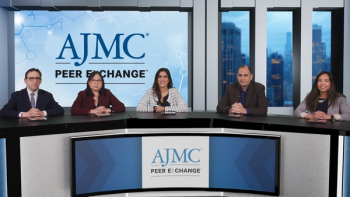
- January 2025
- Volume 31
- Issue Spec. No. 1
- Pages: SP33
MRD and Other Predictors From FELIX for Obe-Cel Success in R/R B-ALL
Key Takeaways
- Obe-cel, a novel CAR T-cell therapy, shows reduced toxicity and improved persistence due to its unique scFv with intermediate affinity.
- The FELIX study reported a 77% remission rate, with a median overall survival of 15.6 months for patients treated with obe-cel.
A month before the 66th American Society of Hematology Annual Meeting and Exposition (ASH 2024) opened in San Diego, California, the FDA approved obecabtagene autoleucel (obe-cel; Aucatzyl, Autolus Therapeutics) for adult patients with relapsed/refractory B-cell acute lymphoblastic leukemia (R/R B-ALL).1
Approval was based on the phase 1b/2 FELIX study (NCT04404660), which appeared in the New England Journal of Medicine (NEJM) on November 27, 2024.2 Study authors presented additional data during ASH 2024 regarding the depth of molecular responses as well as risk stratification that could predict which patients will have the best outcomes.3,4
Authors, including lead US investigator Elias Jabbour, MD, of The University of Texas MD Anderson Cancer Center, outlined in NEJM how obe-cel differs from earlier chimeric antigen receptor (CAR) T-cell therapies. “Unlike tisa-cel [tisagenlecleucel] and brexu-cel [brexucabtagene autoleucel], which both use the same high-affinity single-chain variable fragment (scFv) to recognize CD19, obe-cel uses a different scFv with intermediate affinity due to a fast binding off-rate,” they wrote.2
This difference is believed to reduce toxicity while improving the therapy’s persistence, they wrote; Jabbour referred to patients’ ongoing response as a “plateau,” as seen in the graphic presentation of survival data, which he called “transformative” in CAR T-cell therapy. A study of obe-cel in pediatric patients is recruiting (NCT06173518).
Findings in NEJM show that remission occurred in 77% of the 127 evaluable patients, with 55% having complete remission (CR) and 21% having complete remission with incomplete hematologic recovery (CRi). The median event-free survival (EFS) was 11.9 months, with a 6-month rate of 65.4% and a 12-month rate of 49.5%. Median overall survival (OS) was 15.6 months.2
On the safety front, grade 3 or higher cytokine release syndrome (CRS) developed in only 2.4% of the patients, and grade 3 or higher immune effector cell–associated neurotoxicity syndrome (ICANS) developed in 7.1% of the patients.2 According to experts who discussed obe-cel during a Peer Exchange with The American Journal of Managed Care (AJMC) sister publication OncLive® in November 2024, obe-cel appears to offer a much-improved safety profile without any drop-off in efficacy relative to other CAR T-cell options.5
At ASH, Jabbour presented an abstract highlighting “the correlation between the depth of measurable residual disease (MRD)–negative remission and clinical outcomes” on patients who were treated with obe-cel.3 In short, the results showed that patients who did not achieve an MRD of less than 10-6 had poorer outcomes.
According to the data, 76% of the 127 patients infused with obe-cel had samples available for next-generation sequencing (NGS) analysis; of these 96, 73 patients (76%) achieved CR or CRi, and 68 of the 73 (93%) had at least 1 postinfusion bone marrow sample for NGS evaluation.
Based on best response achieved, 6% of patients had MRD equal to or more than 10-4 leukemic cells, meaning MRD positive, while 94% reached MRD of under 10-4 leukemic cells; in addition, 10% (7/68) had MRD between 10-4 and 10-6 and 84% (57/68) had MRD less than 10-6.
At a median follow-up of 21.5 months, among responders, results were as follows:
- for patients with MRD equal to or more than 10-4: median duration of response (DOR), 1.5 months; median EFS, 0 months; median OS, 2.2 months
- for patients with MRD between 10-4 and 10-6: median DOR, 3.8 months; median EFS, 4.5 months; median OS, 8.9 months for patients with MRD less than 10-6: median DOR, 17.1 months; median EFS, 15.1 months; median OS, not evaluable 12-month EFS rates were 10%, 0%, and 61%, while 12-month OS rates were 20%, 27%, and 85%, respectively.
AJMC spoke with Jabbour about the relationship between the MRD results and patient outcomes, as well as next steps.
AJMC: What did the results show about the relationship between MRD negativity and patient outcomes?
Jabbour: Obe-cel induces a higher rate of MRD negativity by NGS. The patients who respond and achieve MRD negativity by NGS at 1 month post infusion have an improvement in the [EFS and OS]. In fact, 70% of the patients who achieve an MRD-negative remission are alive at a median [follow-up] of up to 21.8 months.
However, the benefit was seen at a higher level in patients with a low tumor burden at lymphodepletion; patients with blast [cells in the bone marrow] above 75% did benefit, but not to the extent of those patients with a lower tumor burden.
AJMC: Are there any particular findings FELIX has shown investigators about sequencing this therapy relative to other therapies that are available for B-ALL?
Jabbour: Compared with the other treatments available for ALL and many other CAR T-cell [therapies], obe-cel is safer, and it seems to induce a plateau where patients do not relapse after a certain time. If they respond, they have the deepest measure—they seem to have a plateau that we have not shown with the other CAR T cells. However, I think what we need to do as a sequence; when you have somebody relapsing, collect them for obe-cel, but then try to start to actually reduce them to the maximum and give CAR T as a consolidation. Because what we’ve seen so far is that patients who respond have a low tumor burden at lymphodepletion, and then obe-cel has the best benefit—survival is at 80% and higher, which is great, and that eventually will offset the need for transplantation.
AJMC: Are there particular characteristics of patients for whom obe-cel is particularly appropriate?
Jabbour: This therapy is safe with the dose [with low rates of] CRS and ICANS, and it has more durable responses with the plateau. Obviously, this should be offered for every patient today with R/R B-ALL.
AJMC: What are the next areas for study?
Jabbour: With the promising evidence we have today, we need to move [it], obviously, to the front line—that will happen in 2025.
References
1. FDA approves obecabtagene autoleucel for adults with relapsed or refractory B-cell precursor acute lymphoblastic leukemia. News release. FDA. November 8, 2024. Accessed December 13, 2024. https://www.fda.gov/drugs/resources-information-approved-drugs/fda-approves-obecabtagene-autoleucel-adults-relapsed-or-refractory-b-cell-precursor-acute
2. Roddie C, Sandhu KS, Tholouli E, et al. Obecabtagene autoleucel in adults with B-cell acute lymphoblastic leukemia. N Engl J Med. 2024;391(23):2219-2230. doi:10.1056/NEJMoa2406526
3. Jabbour E, Park JH, Shaughnessy P, et al. Obecabtagene autoleucel (obe-cel) for adult relapsed/refractory B-cell acute lymphoblastic leukemia (R/R B-ALL): deep molecular remission may predict better outcomes. Presented at: 66th American Society of Hematology Annual Meeting and Exposition; December 7-10, 2024; San Diego, CA. Abstract 963.
4. Roddie C, Park JH, Shaughnessy P, et al. Risk factors associated with sub-optimal outcomes following obecabtagene autoleucel (obe-cel) for relapsed/refractory B-cell acute lymphoblastic leukemia (R/R B-ALL): what we have learned from the FELIX trial. Presented at: 66th American Society of Hematology Annual Meeting and Exposition; December 7-10, 2024; San Diego, CA. Abstract 4845.
5. Doherty K. Obe-cel approval expands CAR T-cell therapy options in relapsed/refractory ALL. OncLive. 2024;25(15):22-25. https://www.onclive.com/view/obe-cel-approval-expands-car-t-cell-therapy-options-in-relapsed-refractory-all
Articles in this issue
Newsletter
Stay ahead of policy, cost, and value—subscribe to AJMC for expert insights at the intersection of clinical care and health economics.












































